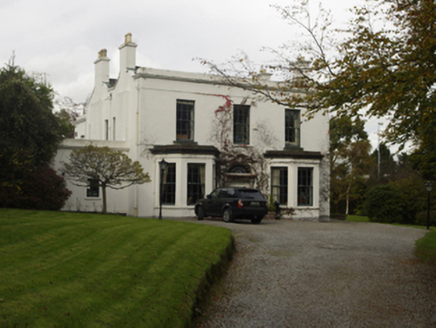Survey Data
Reg No
60230045
Rating
Regional
Categories of Special Interest
Architectural, Artistic, Historical, Social
Previous Name
Hill Side
Original Use
House
Date
1855 - 1865
Coordinates
321991, 226191
Date Recorded
24/10/2014
Date Updated
--/--/--
Description
Detached three-bay two-storey double-pile house, extant 1862, on a square plan. Occupied, 1911. Sold, 2006. For sale, 2015. Pitched double-pile (M-profile) slate roof behind parapet with clay ridge tiles, coping to gables with rendered chimney stacks to apexes having stepped capping supporting terracotta or yellow terracotta tapered pots, and concealed rainwater goods retaining cast-iron octagonal or ogee hoppers and downpipes. Part creeper- or ivy-covered rendered, ruled and lined walls on "bas-relief" plinth with lead-covered "Cyma Recta"- or "Cyma Reversa"-detailed cornice on blind frieze below parapet. Segmental-headed central door opening with cut-granite step threshold, cut-limestone doorcase with three quarter-engaged columns on plinths supporting "Cyma Recta"- or "Cyma Reversa"-detailed cornice on blind frieze on entablature, and concealed dressings framing timber panelled door having fanlight. Square-headed window openings including square-headed window openings to rear (west) elevation with cut-granite sills, and concealed dressings framing six-over-six timber sash windows. Interior including (ground floor): central hall retaining egg-and-dart-detailed carved timber lugged surrounds to door openings framing timber panelled doors, egg-and-dart-detailed decorative plasterwork cornice to ceiling, cantilevered staircase on a dog leg plan with turned timber balusters supporting carved timber banister terminating in volute, carved timber surrounds to door openings to landing framing timber panelled doors, and moulded plasterwork cornice to ceiling; dining room (south-east) retaining carved timber lugged surround to door opening framing timber panelled door with carved timber surround to window opening framing timber panelled reveals or shutters on panelled risers, cut-white marble Classical-style chimneypiece, and egg-and-dart-detailed decorative plasterwork cornice to ceiling centred on decorative plasterwork ceiling rose; drawing room (north-east) retaining carved timber lugged surround to door opening framing timber panelled door with carved timber surround to window opening framing timber panelled reveals or shutters on panelled risers, cut-white marble Classical-style chimneypiece, and egg-and-dart-detailed decorative plasterwork cornice to ceiling centred on decorative plasterwork ceiling rose; sitting room (north-west) retaining carved timber lugged surround to door opening framing timber panelled door with carved timber surround to window opening framing timber panelled shutters on panelled risers, cut-white marble Classical-style chimneypiece, and egg-and-dart-detailed decorative plasterwork cornice to ceiling centred on decorative plasterwork ceiling rose; and carved timber surrounds to door openings to remainder framing timber panelled doors with carved timber surrounds to window openings framing timber panelled shutters on panelled risers. Set in landscaped grounds.
Appraisal
A house representing an integral component of the mid nineteenth-century domestic built heritage of south County Dublin with the architectural value of the composition, one of the 'several villa residences and elegant mansions…of a very superior character' mentioned in The Dublin Builder (1st June 1861, 522; cf. 60230031; 60230043; 60230044; 60230047; 60260176; 60260185), suggested by such attributes as the compact near-square plan form centred on a Classically-detailed doorcase not only demonstrating good quality workmanship in a deep grey limestone, but also showing a pretty fanlight; the diminishing in scale of the openings on each floor producing a graduated tiered visual effect with the principal "apartments" or reception rooms defined by polygonal bay windows; and the parapeted roofline. Having been well maintained, the elementary form and massing survive intact together with substantial quantities of the original fabric, both to the exterior and to the interior where contemporary joinery; Classical-style chimneypieces; and decorative plasterwork enrichments, all highlight the artistic potential of a house having historic connections with James Henry Webb (d. 1868), 'Merchant formerly of Greenmount Harold's-cross and late of Hillside Stillorgan County Dublin' (Calendars of Wills and Administrations 1869, 572); and George Richard Armstrong MD (d. 1929), 'Physician [and] Surgeon' (NA 1911).

